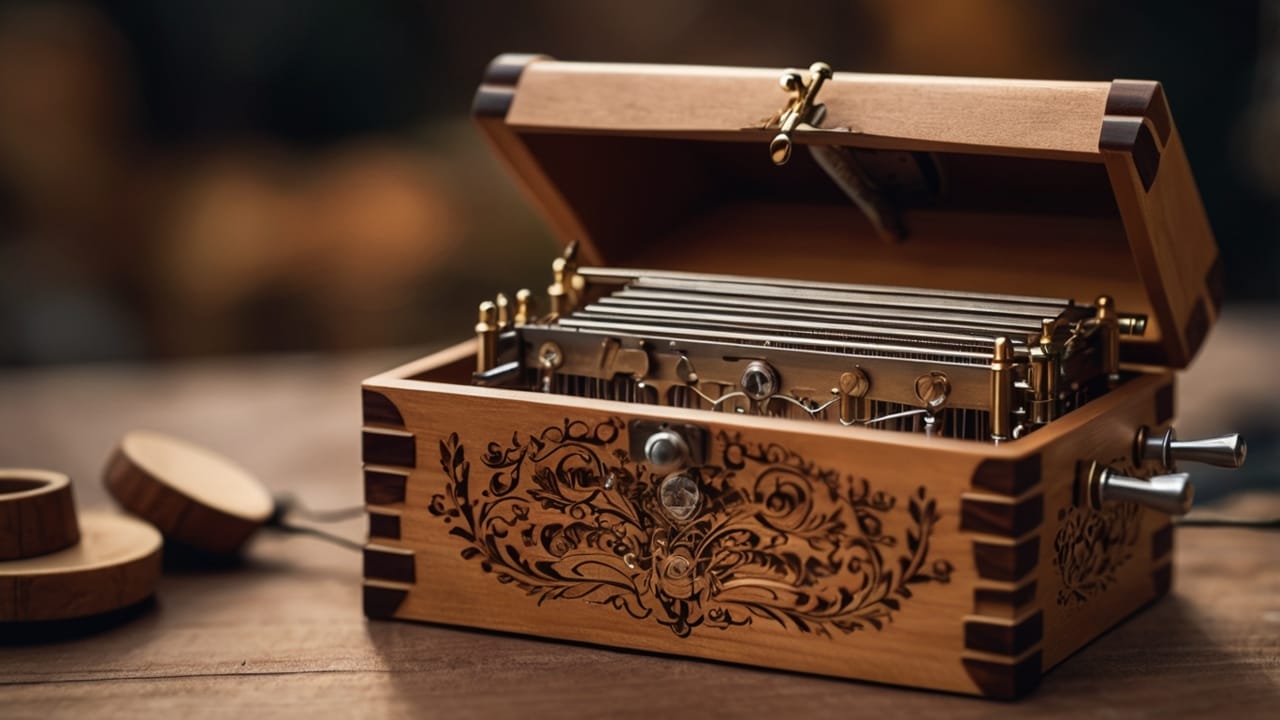Explore a simpler time when beautifully crafted objects brought joy, nostalgia, and aesthetic pleasure. Not just utility.
Music boxes: instruments wrapped in an aura of enchantment and nostalgia which have delighted and uplifted hearts for centuries. These objects have always symbolized magic, cherished memories, and timeless beauty, with their soothing melodies and intricately designed cases.
But have you ever wondered about the history behind these delightful inventions?
Join us as we take a trip through the history of music boxes.
The origins of music boxes
Music boxes originated in the 18th century, a period of impressive technological advancements in mechanical arts across Europe. These miniature marvels of craftsmanship were initially crafted to fit into snuffboxes and other pocket-sized items.
These beautiful musical treasures weren't just decorative items. They were a perfect mix of art and engineering. Every music box was a testament to the maker's skill and creativity. With intricate mechanisms tucked beneath their elegant exteriors.
While they might appear simple on the outside, the inner workings of these early music boxes were anything but. It was an impressive display of cleverness and exactness. Craftsmen carefully crafted each component. Making sure the revolving cylinder, the protruding pins, and the tuned teeth of the steel comb worked together perfectly.
Early music box designs
The earliest music boxes were purely mechanical and relied on a revolving cylinder with tiny protruding pins. As the cylinder revolved, these pins would pluck the tuned teeth of a steel comb, thus producing sweetly tuned melodies. The melodies that emanated from these delicate instruments were mesmerizing, transporting listeners to a world of enchantment and beauty.
Despite being expensive luxury items available only to the society's elite, these early renditions were fairly simple, usually playing one to two tunes. However, with time, these humble creations would evolve into masterpieces of mechanical programming.
As the demand for music boxes grew, skilled artisans and inventors sought ways to enhance their capabilities. They tirelessly experimented with different designs and mechanisms, striving to create music boxes that could play a wider range of melodies with greater complexity.

Notable inventors and innovations
The pioneers of this technological marvel were:
- Antoine Favre: A Swiss watchmaker known for inventing the singing bird box
- David LeCoultre: From the well-known Swiss watch and clock-making family
- Nicole Frères: A French musical box company responsible for inventing the interchangeable cylinder in 1828
Their contributions to the world of music boxes were invaluable, as they were instrumental in making critical improvements to the mechanical design and functioning of these devices.
Under the guidance of these visionaries, music boxes began to evolve at a rapid pace. Innovative features were introduced, such as musical automata and interchangeable cylinders. The introduction of interchangeable cylinders was a revolution in music box design, allowing for an increased repertoire of tunes. Owners could now swap out cylinders to enjoy a variety of melodies, further enhancing the allure of these captivating devices.
With each passing year, music boxes became more intricate and sophisticated. Skilled craftsmen pushed the boundaries of what was possible, incorporating breathtaking details into their creations. Elaborate engravings adorned the cases, depicting scenes of nature, love, and mythological tales. Precious materials like gold, silver, and ivory were used to elevate the aesthetic appeal of these musical marvels.
Music boxes became cherished heirlooms, passed down through generations, each one carrying with it a rich history and a unique story. They became symbols of elegance and refinement, captivating the hearts of those fortunate enough to own one.

The evolution of music boxes
The progression of music boxes didn't stop with Favre or LeCoultre. The 19th century marked a golden era, where music boxes underwent significant transformations. Evolving from the cylinder to a disc mechanism, and being influenced by advances in mass production.
From cylinder to disc mechanism
The shift from cylinder to disc was a major milestone, offering variety and interchangeability. These disc music boxes had a series of punched holes, representing a musical score. The adoption of this mechanism allowed music boxes to play longer pieces of music and gave birth to an entire industry of punch-card operated music boxes.
What marked this shift as particularly significant was that this innovation made music boxes more affordable and accessible to the general public. Making them a prominent feature in many homes across Europe and America.
The impact of industrial revolution on music box production
The Industrial Revolution played a critical role in further popularizing music boxes. With the invention of steam-powered machinery, large-scale manufacturing became possible. Driving down costs and making these delightful devices available to a larger audience.
In addition to affordability, the Industrial Revolution also introduced other modifications such as larger disc machines capable of providing entertainment in public establishments and coin-operated models, the forerunners of modern jukeboxes.

Music boxes around the world
While Europe, particularly Switzerland, was the main producer of music boxes, they were also embraced with great fondness and artistry in other regions around the world.
Swiss mastery: music boxes in Switzerland
Switzerland was at the vanguard of music box production in the 19th century. With a long history of excellence in watchmaking, it's not surprising that Swiss artists also excelled in music box craftsmanship.
Cities such as Geneva became hubs for stunningly crafted "machine music".
Swiss music boxes from this era were known for their superior sound quality, rich tonal texture, and the perfection of their musical arrangements. These treasured artifacts continue to command respect and fascination to this day.
Japanese Kikori: the art of automaton music boxes
While music boxes found fertile ground in Switzerland, they also flourished in Japan, where they married traditional craftsmanship with innovative mechanical design. Famous for their automaton music boxes, the Yokohama-based studios churned out pieces of incredible artistic and mechanical complexity.
Not just objects of sound, these creations included lifelike moving figurines, waterfalls, and windmills.
They were more than just music boxes. They were immersive experiences, entrancing the eyes as much as the ears.
If you're interested in Japanese cultural heritage, you might also like these:


The golden age of music boxes
The 19th century is often seen as the golden age of music boxes. This was the era when these instruments were at their peak. With the release of intricate designs and beautifully engineered pieces.
The rise of music box popularity in the 19th century
During the 19th century, music boxes reached unprecedented levels of popularity. One could find them in well-to-do homes across Europe and America, elegantly encased in hardwood. More than an innovative piece of mechanical marvel, they became a status symbol of affluence and an epitome of cultured refinement.
From small pocket-sized instruments to large cabinet-style symphonions, the variety of music boxes was mesmerizing. These spirited melodies even found their way into public spaces. Adding to the charm of cafes, ice cream parlors, and arcades.
Iconic music box manufacturers and designs
Companies like Polyphon and Symphonion revolutionized the music box industry with their innovative designs and high-quality sound mechanisms. Their contribution to this era is unparalleled and their designs are still admired and collected today.
During this time, music boxes became more than simple wooden boxes. They were transformed into carefully crafted pieces of art. Each flaunting intricate detailing and made from an array of materials such as birch, rosewood, and even ivory.

The decline and resurgence of music boxes
Despite their immense popularity in the 19th century, the dawn of the 20th century brought new technological advancements which began to overshadow these miniature musical marvels.
The threat of phonograph and gramophone
In the late 19th and early 20th century, the advent of the phonograph and gramophone posed a serious threat to the survival of music boxes. Their ability to reproduce a wide range of sounds, including speech, and play longer pieces of music, made them more appealing to the masses.
Subsequently, music boxes started to fade into obscurity.
But contrary to what many believed, this was not the end for music boxes.
The modern revival of music boxes
In modern times, there has been a resurgence in popularity for these charming music makers as they are appreciated both for their history and their craftsmanship.
Antique music boxes are now highly prized collectible items. Admired by those who value their mechanical complexity, aesthetic appeal, and sentimental value.
Even in our digital age, mechanical music boxes still enchant us. They take us back to a simpler time when beautifully crafted objects brought joy, nostalgia, and aesthetic pleasure. Not just utility.
The history of music boxes is a captivating mix of creativity, innovation, and resilience – a testament to our enduring love for music and the art of craftsmanship. Their small size seems almost at odds with the huge impact they had on the music and entertainment industry.
And today, even with all our technological advancements, the melody of a music box still touches chords in many hearts.





